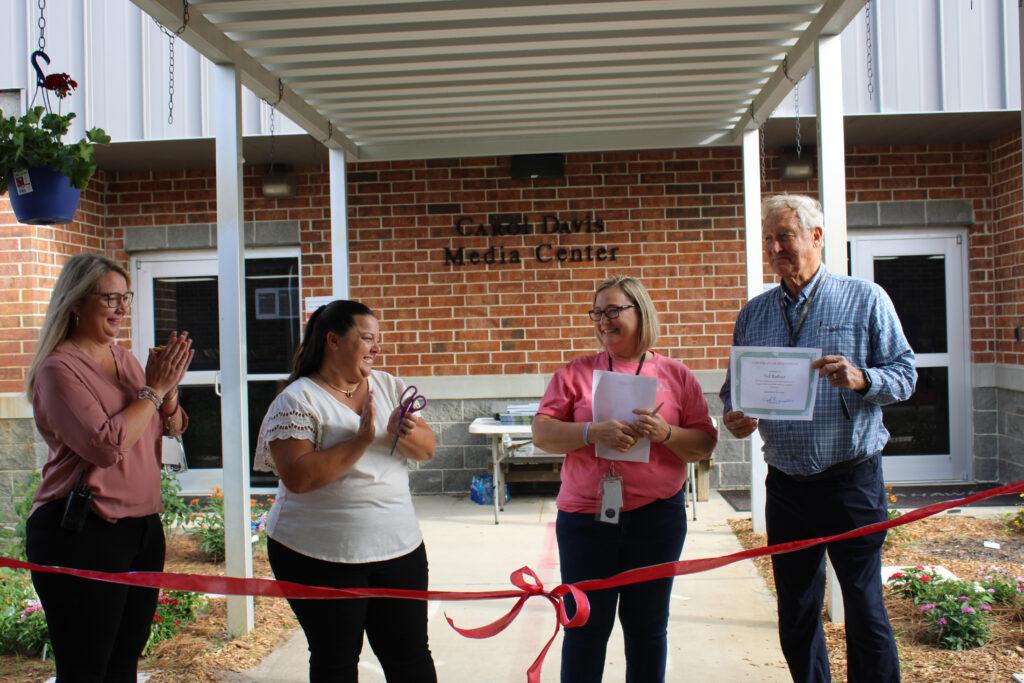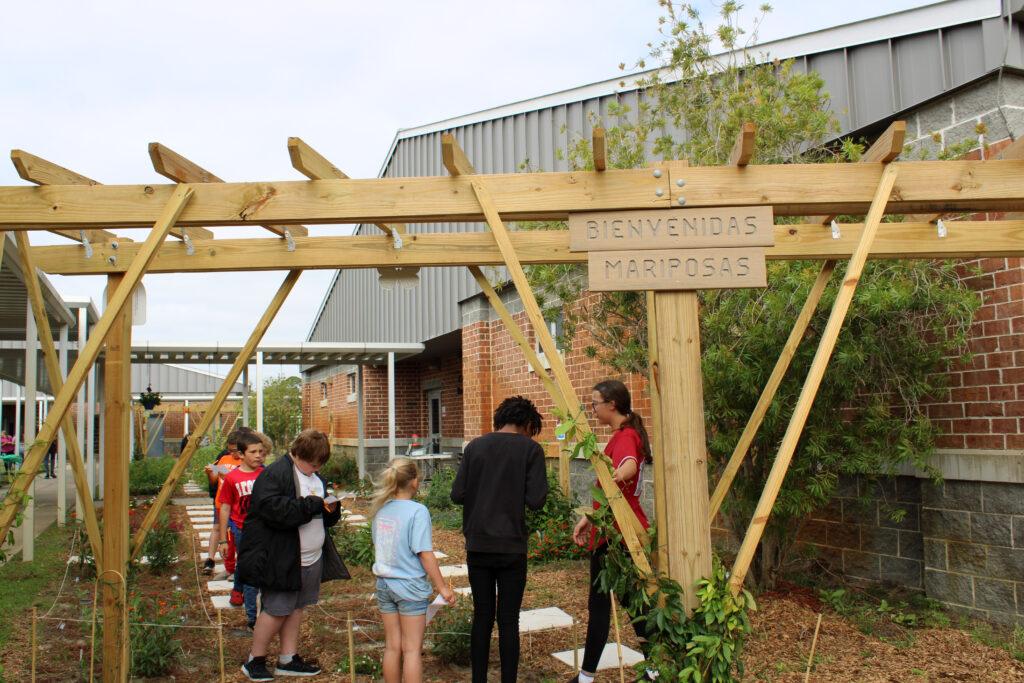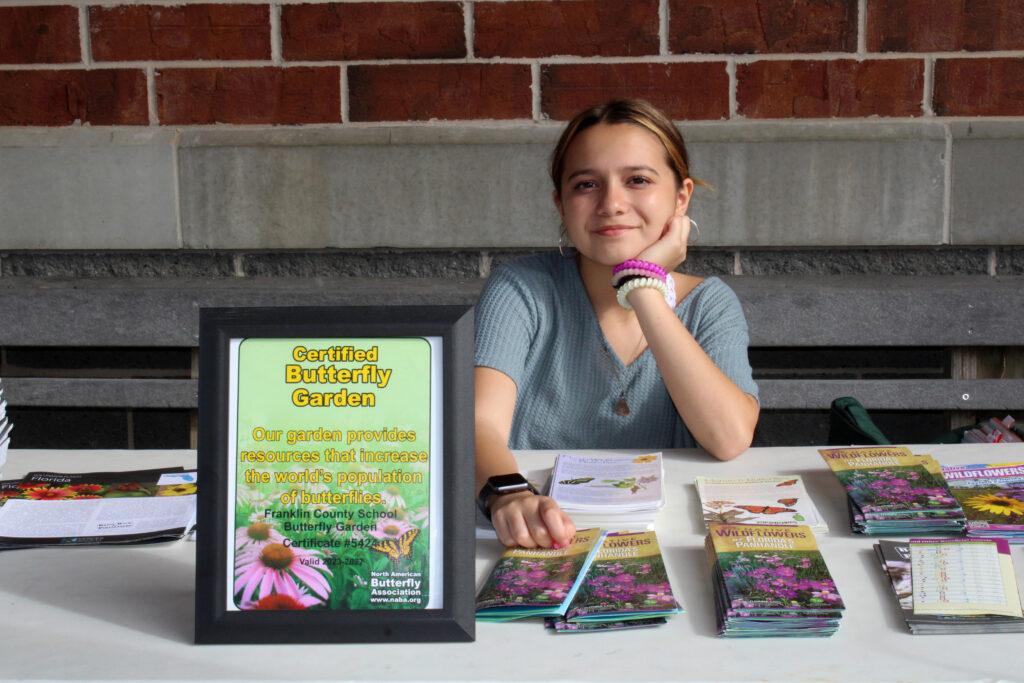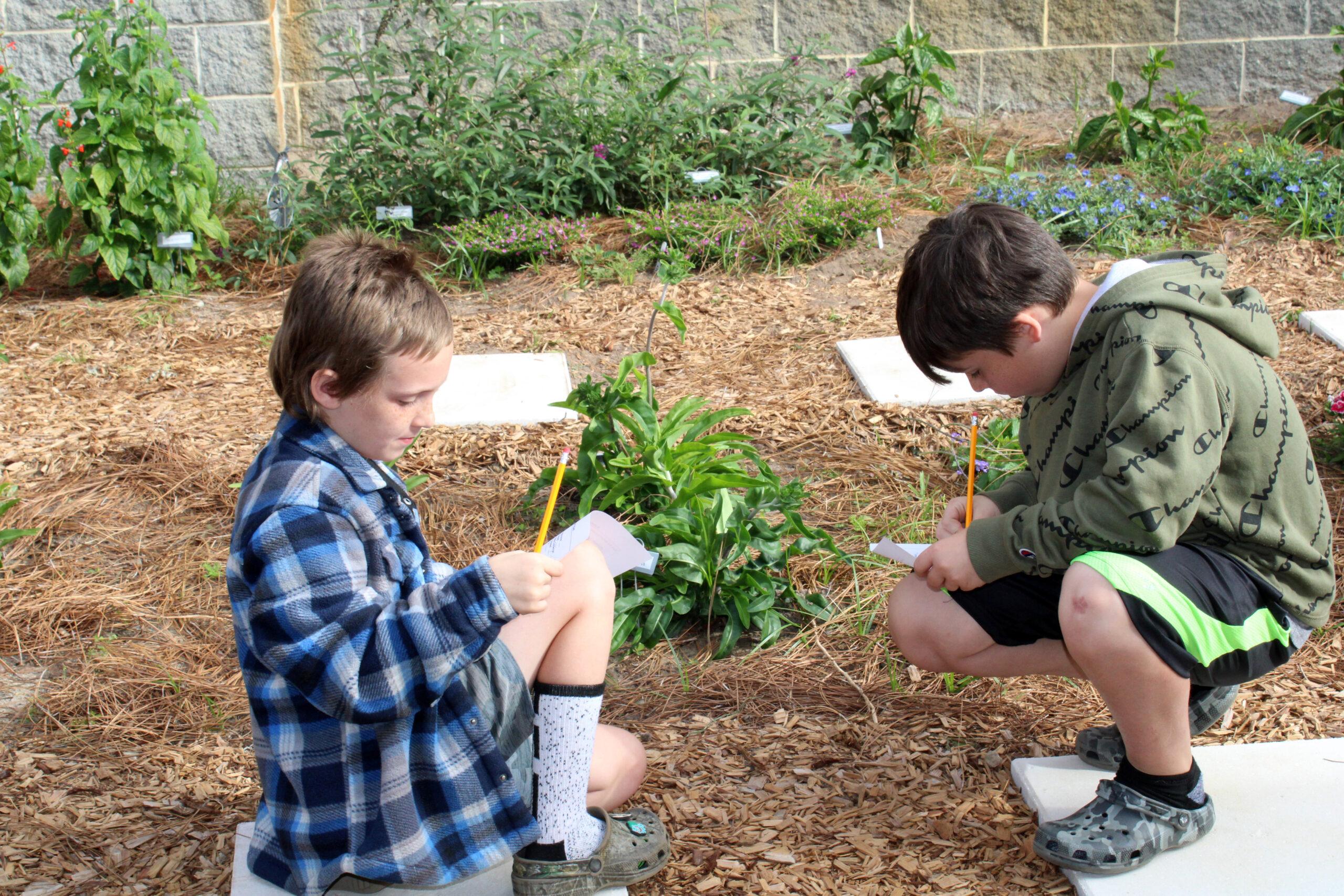Butterflies flutter to new FCS garden
On what was once a barrow pit, an expanse of ditches dug to supply fill dirt for roadways, has sat the Franklin County High School for more than a dozen years, a fairly plain-looking set of brick buildings on a treeless landscape.
Now, however, there are bright flowers and butterflies gracing the space between the offices and the media center.
The school debuted the new garden at a ceremony last month, getting all the students in on the moment, from the littlest who ventured among the flowers to make identifications, to those who got face painted and the older ones, who read up on the migrating patterns of the Rhopalocera.
Elementary school teacher Leigh Smith and support staff Allison Chipman had sought help in the creation of the garden a year or so ago, and so the Franklin County Extension Office referred them to Eastpoint’s Ted Ruffner.

Ruffner had gone through the master gardener program in Wakulla County five years ago, and had worked on one for a decade at the Apalachicola National Estuarine Research Reserve, before Hurricane Michael took it out, and another one at the Franklin County library branch in Eastpoint and of course at his home in Gramercy Plantation, which is adjacent to the school.
“In August, they told me here’s the area we got to work with,” said Ruffner, whose exuberance for his passions is as distinctive as the markings on a monarch. “I told them I’ll take the whole thing over. I know a lot about butterfly gardens.”
His first order of business was to have Gary Martina plow up the sod and disc the area so Ruffner could work the land.
“There were rocks and rebar and junk in the soil,” he said. “I put in bags and bags and bags of mushroom compost and peat moss, and rototilled that in three times.”
Mike Todd’s construction class at the school went to work building a pair of gazebos, two 20-foot arbors so that the sort of vines, like common milkweed, could flourish and feed them.

“A caterpillar is nothing but an eating machine,” Ruffner said. “As soon as it gets tired of crawling, it makes a chrysalis and it goes through metamorphosis.”
With the help of a nurturing box, Ruffner selected five species of milkweed, and used as many native plants as possible, because so many varieties of caterpillars are picky eaters.
“For monarchs, milkweed has a poisonous sap that is poisonous for others,” he said. “The butterfly we see on bridges is called a gulf fritillary, and their caterpillar only uses passion vine which in order to grow has to have arbor. And there’s arbors for pipe vine, and for Carolina jasmine, now that’s a pretty vine.”
Now of course, a garden needs a lot more than vines for caterpillars, so Ruffner set about selecting the right assortment of flowers for attracting butterflies.
“Many butterflies will go to lots of different flowers for nectar,” he said. “They’ll even go to rotten fruits and bananas.
Ruffner chose from over 300 plants, selecting different colors, varying heights and differing times they bloom.

“Some will bloom all the way to December,” he said. “We had flowers in February and we had monarchs in February because I had saved milkweed in my garage.
“I scrounged root stock from friends, and some were made from cuttings,” Ruffner said. “We had a very severe winter, and three days of cold killed a lot of things that don’t usually die.”
He obtained a pollinator mix from the Florida Wildflower Foundation, an assortment of annual seeds for native flowers, for planting in the beds he made, in the soil he had tended.
Butterfly bush, fire bush, cardinal flower, lantana, tropical sage, blue porter weed, three varieties of the state flower coreopsis, purple cone flower, blanket flower, Stoke’s aster – take your pick of what Ruffner planted.
Among his choices were coral honeysuckle, which attracts a lot of different butterflies, as well as hummingbirds and other pollinators.
The final product, at least so far, has been 2,500 square feet of garden and 200 feet of paths with pavers.
Plus Ruffner added a screened-in rearing box, where they can watch the chrysalis transform. “The kids are just going gaga over that,” he said.

Of course with a mixture of perennials and annuals, the garden will need some plants replaced and Ruffner is committed to the work. The school provides a state-of-the-art sprinkler system and has placed mulch between the pavers and other enhancements to ensure continued success.
“I’m looking at butterflies in my garden and I know they visit both these gardens on the same day,” he said.
The signs that greet visitors are in both English and Spanish, declaring “Bienvenidas Mariposas” to the returning butterflies.
“That garden is an oasis in a desert,” said Ruffner. “They can fly across the barren playground, and now they will come. But it would be nice if there was a little more landscaping around the school.
“We could go in the woods and dig up yaupon and wax myrtle, and there’s lots of seaside goldenrod,” he said. “We could plant some of those growing wild with no care, and it might cheer up the kids a little. It would also have an effect on the butterflies, as a place to stop and transition, a way station.”
At the formal opening of the garden, the school made Ruffner an honorary Seahawk, and he was his usual enthusiastic self.
“Our school may not be the biggest school in the state, but we have a state championship garden and it’s going to get better,” he said.
On a personal note, he said he had a thought in his mind in embarking on his creation.
“I wanted to do something in Pam Nobles’ memory,” Ruffner said. “It was a labor of love and I’m so proud of it.”




Meet the Editor
David Adlerstein, The Apalachicola Times’ digital editor, started with the news outlet in January 2002 as a reporter.
Prior to then, David Adlerstein began as a newspaperman with a small Boston weekly, after graduating magna cum laude from Brandeis University in Waltham, Massachusetts. He later edited the weekly Bellville Times, and as business reporter for the daily Marion Star, both not far from his hometown of Columbus, Ohio.
In 1995, he moved to South Florida, and worked as a business reporter and editor of Medical Business newspaper. In Jan. 2002, he began with the Apalachicola Times, first as reporter and later as editor, and in Oct. 2020, also began editing the Port St. Joe Star.